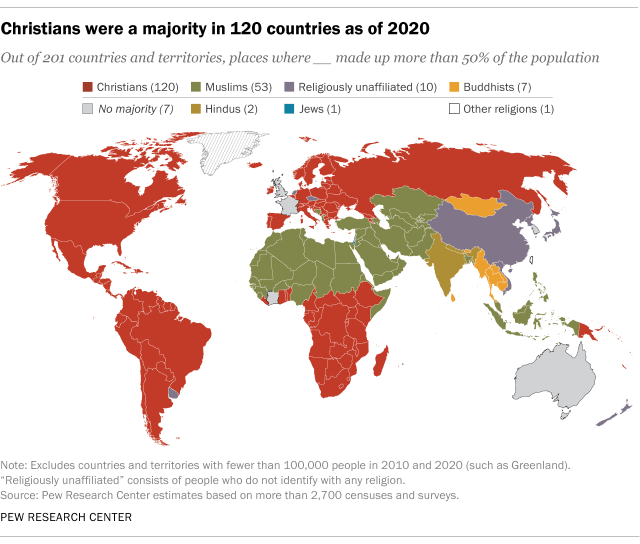
Most countries have Christian majorities – that is, more than half of all people in those places identify as Christian, according to a recent Pew Research Center report.
However, the Christian share of the population has dropped in many countries. And some countries lost their Christian majority between 2010 and 2020, largely because millions of Christians around the world left the religion.
Countries that lost their Christian majorities all saw growing percentages of religiously unaffiliated people – a broad group that includes those who say they have no religion or who identify religiously as atheist, agnostic or “nothing in particular.”
Overall, we estimate that 120 out of the 201 countries and territories we studied had Christian majorities in 2020 – four fewer than in 2010. Meanwhile, 10 countries had religiously unaffiliated majorities in 2020 – three more than in 2010.
This means that Christian-majority countries made up 60% of all the world’s countries and territories in 2020, down from 62% a decade earlier. And places with unaffiliated majorities made up 5% of all countries, up from 3%.
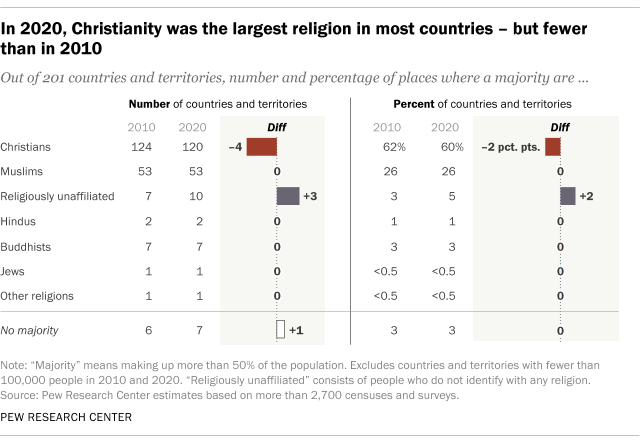
Which countries lost their Christian majority or gained a religiously unaffiliated majority?
Between 2010 and 2020, Christians lost their majority status in the United Kingdom (where they made up 49% of the population as of 2020), Australia (47%), France (46%) and Uruguay (44%).
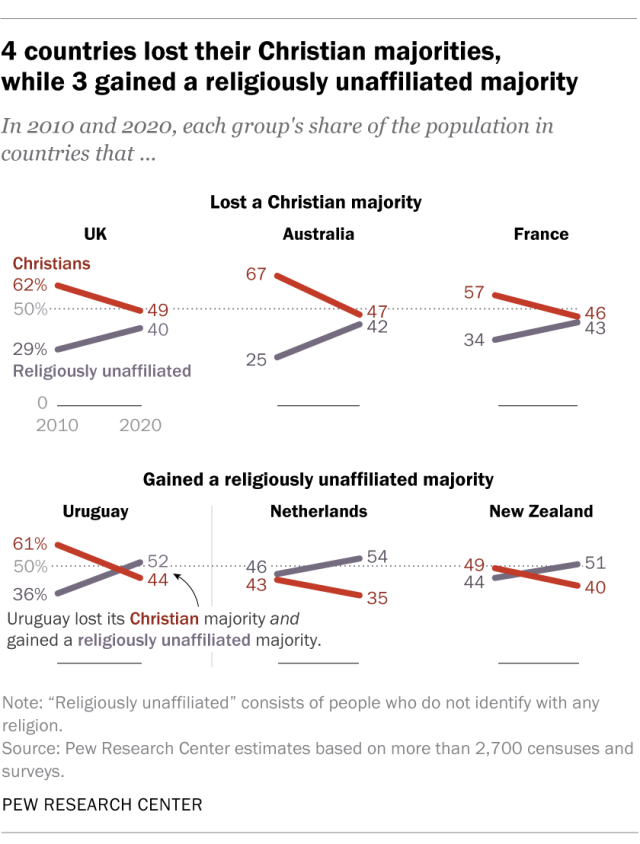
In three of these countries – the UK, Australia and France – no religious group held a majority in 2020. But the religiously unaffiliated category continued to be the second-largest in all three places, approaching Christians in size.
In Uruguay, the religiously unaffiliated category surpassed Christians in size and accounted for 52% of the population in 2020. Uruguay was the only country in the Americas that didn’t have a Christian majority that year.
In addition to Uruguay, two other countries gained religiously unaffiliated majorities between 2010 and 2020: the Netherlands (54% unaffiliated in 2020) and New Zealand (51%). They joined seven others that already had religiously unaffiliated majorities in 2010: China (90% unaffiliated in 2020), North Korea (73%), the Czech Republic (73%), Hong Kong (71%), Vietnam (68%), Macao (68%) and Japan (57%).
Did any other countries see a change in their majority religion?
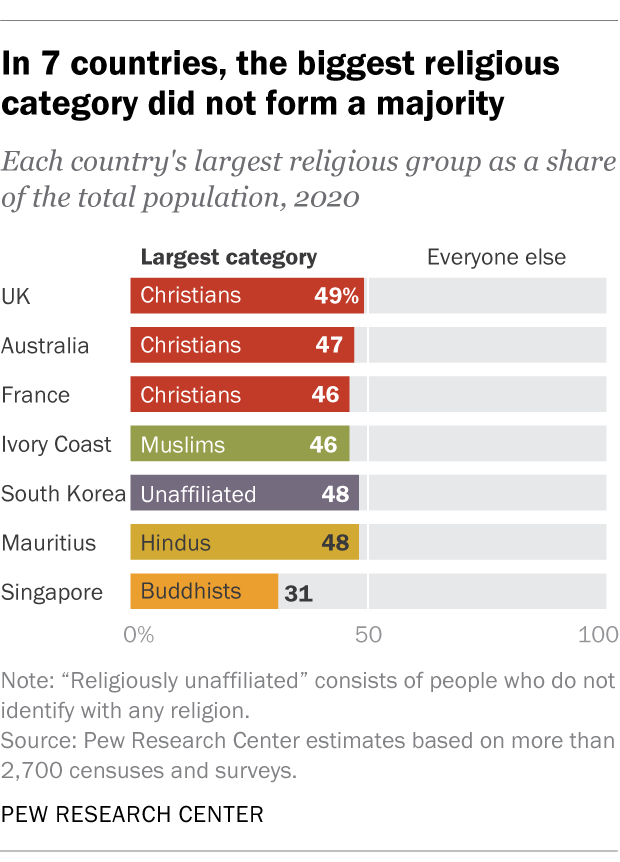
Between 2010 and 2020, there was no change in the number of countries or territories in which the majority of the population is Muslim (53), Buddhist (7), Hindu (2), Jewish (1) or followers of other religions (1).
But the number of countries without any religious majority rose from six to seven. These countries included Ivory Coast (where Muslims are the largest group but not the majority); Mauritius (Hindus); Singapore (Buddhists); and South Korea (religiously unaffiliated). They also included the UK, Australia and France – which, as described above, lost their Christian majorities.
The share of countries that are majority Christian far exceeds the Christian share of the world’s population
The share of countries where a certain religious group is the majority does not necessarily correspond to that religious group’s share of the global population.
For example, only 1% of all countries or territories had Hindu majorities as of 2020, even though Hindus made up 15% of the global population. That is because 95% of the world’s Hindus lived in India – which in 2020 was the world’s second-most populous country. India and Nepal were the two only Hindu-majority countries that year.
Likewise, only 5% of countries had religiously unaffiliated majorities, even as this group accounted for 24% of the world’s people. This is largely because religiously unaffiliated people were heavily concentrated in China, which in 2020 was the world’s most populous country: Two-thirds of all unaffiliated people lived there that year.
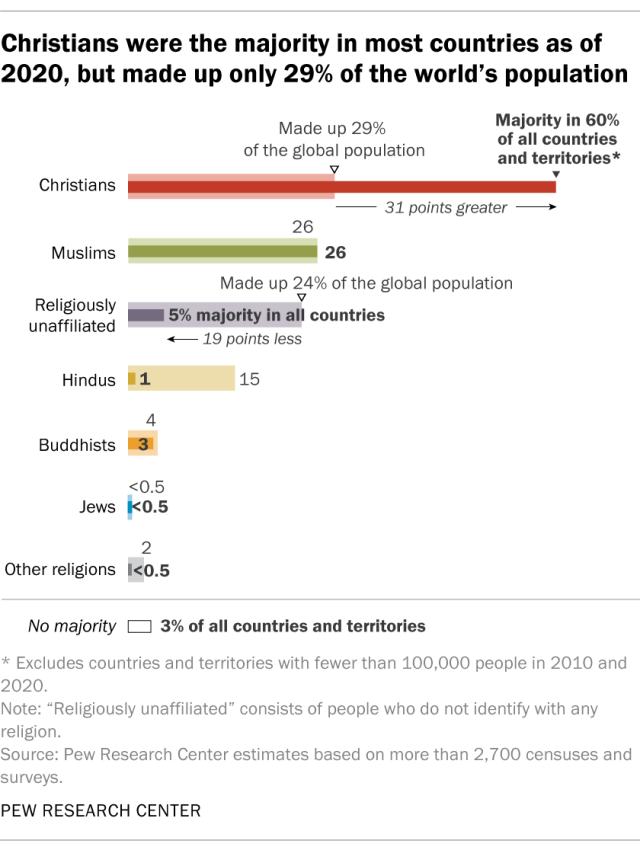
By contrast, Christians were a majority in 60% of all countries and territories we studied, even though they only made up 29% of the world’s population in 2020. This is because Christians were more evenly dispersed geographically and formed majorities in countries of all population sizes – from tiny Micronesia to the United States, the world’s third-most populous country. Christians also made up a small share of the two countries with more than 1 billion people: India and China.
When it comes to two other major world religions – Islam and Buddhism – the shares of countries where adherents formed majorities in 2020 was very close to these religions’ shares of the world population.
CORRECTION (Aug. 1, 2025): A previous version of the chart “Christians were a majority in 120 countries as of 2020” incorrectly shaded the Philippines in green rather than red. The chart has been replaced. The country was originally coded as majority Christian, so this change does not substantively affect the findings of this analysis.
